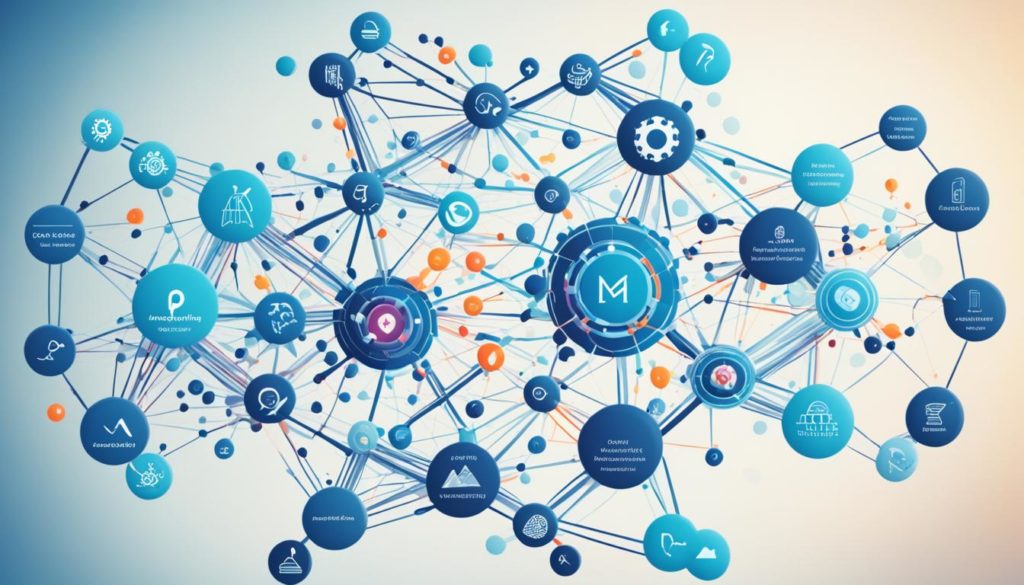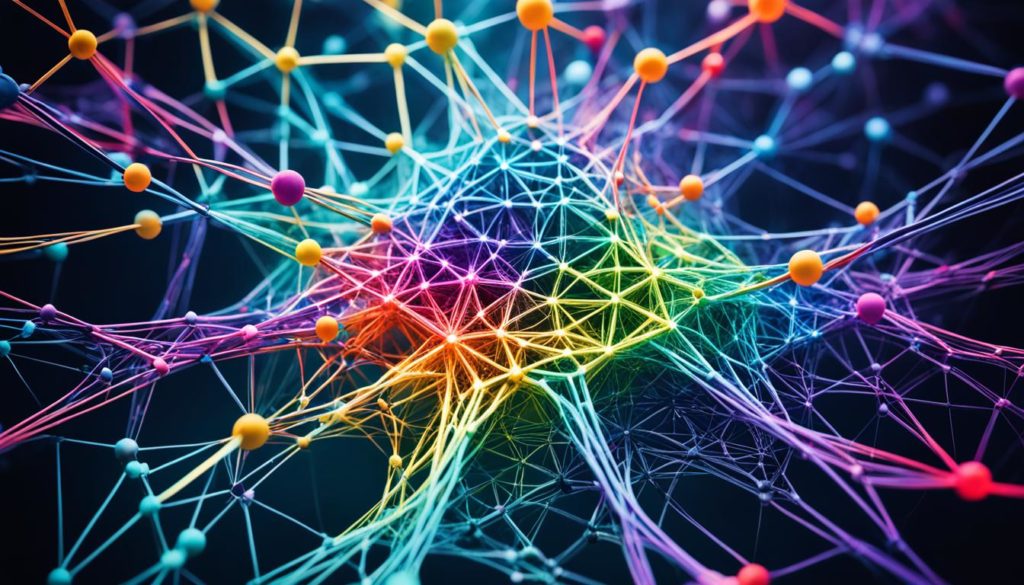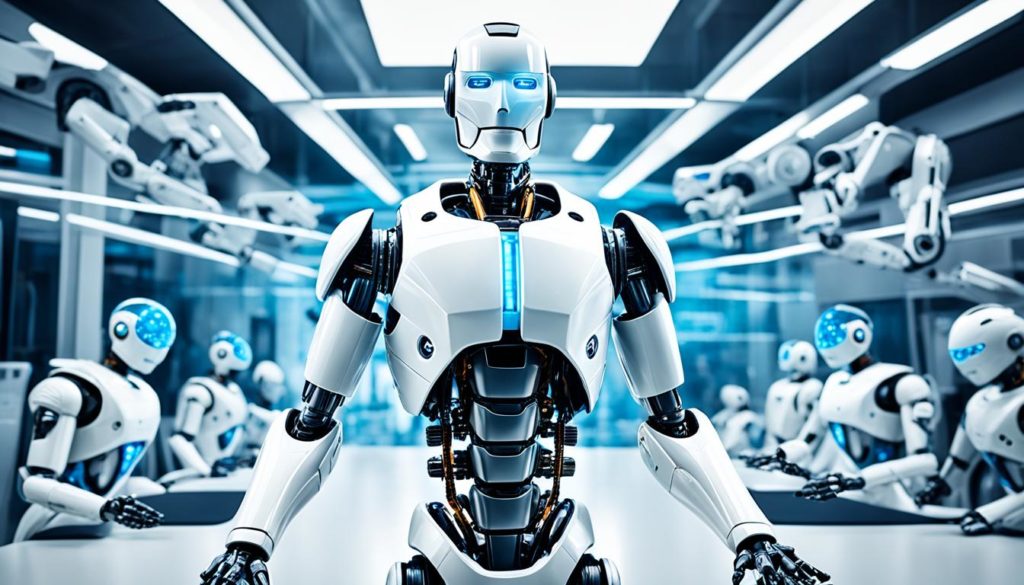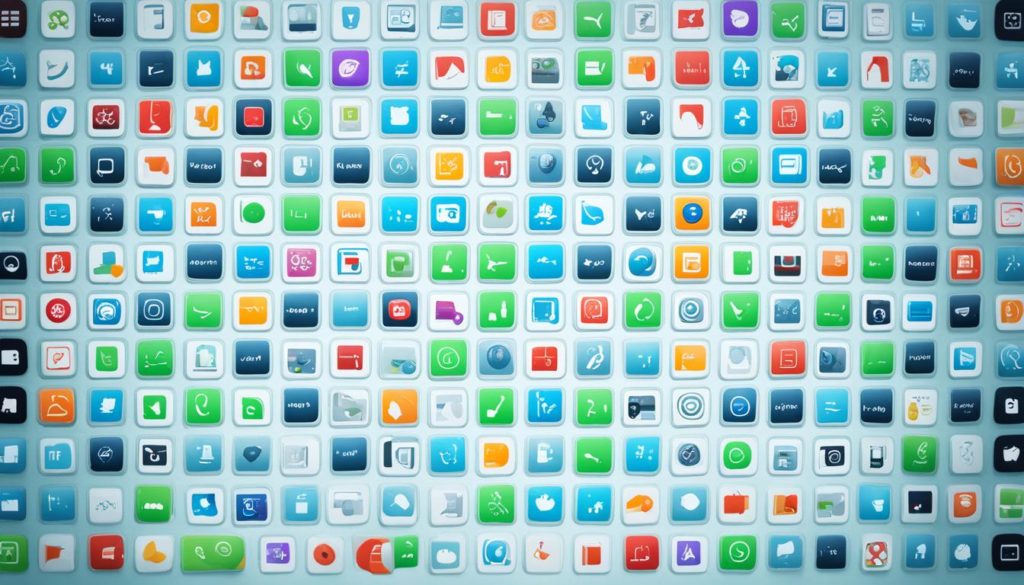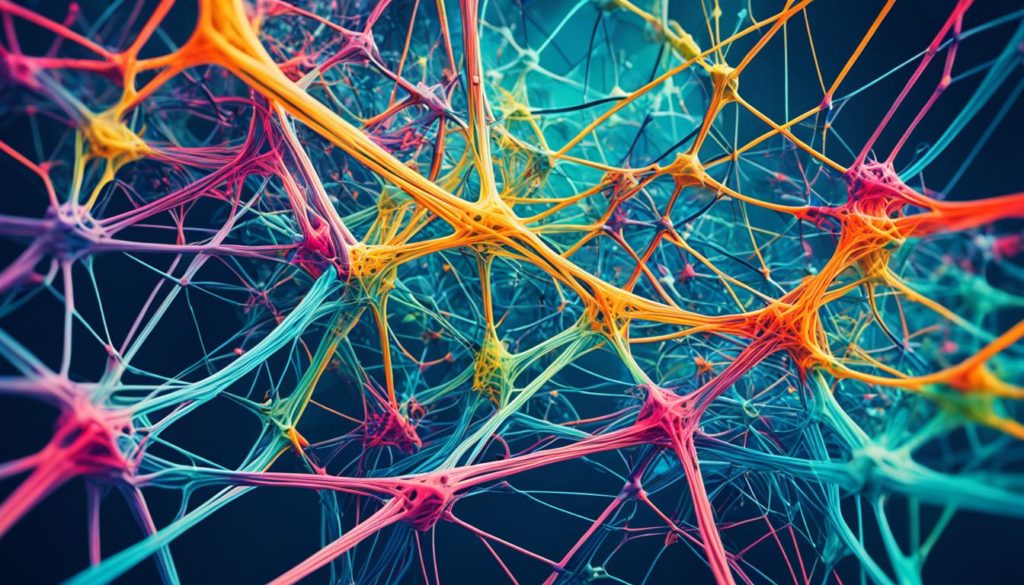
Did you know the global AI market is on track to hit $190.61 billion by 2025? This shows how quickly artificial intelligence is being adopted. And it’s the machine learning libraries that are key in making smart solutions for all kinds of industries.
AI frameworks such as TensorFlow, PyTorch, and Scikit-learn are essential for making AI models. They provide many tools and libraries. These tools have changed how developers use machine learning, making it easier and more effective. For example, TensorFlow by Google is known for being very well documented and compatible. On the other hand, PyTorch by Facebook has a unique way of handling computations. Choosing the right framework can make or break a project.
Key Takeaways
- TensorFlow, developed by Google, is one of the most popular AI frameworks, known for its extensive tools and libraries.
- PyTorch, created by Facebook, is favored for its intuitive interface and ease of use.
- Scikit-learn is widely used for versatile machine learning tasks such as classification and clustering.
- Choosing the right AI framework involves considering scalability, flexibility, and community support.
- These frameworks play a crucial role in shaping AI model development across various applications, from academia to industry.
If you want to know more about these frameworks and what they can do, take a look at this comprehensive guide. In the AI world, keeping up with the latest tech is crucial. This way, you can make the most of what these machine learning libraries offer.
Introduction to AI Frameworks
Artificial Intelligence (AI) is now the foundation of tech growth, sparking new advances in many areas. AI frameworks are key in this change. They simplify how AI is made, opening it up to more people. If you’re working with neural networks or data science, these tools are a must.
What are AI Frameworks?
AI frameworks are like toolkits for building and using AI models. They come packed with everything needed, like standard methods and ready-to-use parts. This means developers don’t have to sweat the small stuff. They can focus on solving big issues. This is a big deal, making it easier for new and old developers to create smart solutions.
Why Are AI Frameworks Important?
AI frameworks are a game-changer. They slash the time needed to make AI and blend it into apps smoothly. These tools also make AI development easier and more uniform. This leads to smarter tech. The right framework can supercharge the work of developers and scientists, leading to groundbreaking projects.
Key Considerations When Choosing an AI Framework
Picking the right AI framework is vital for your project’s triumph. Here are important factors to think about:
- Performance: Make sure the framework can keep up with your project’s size and complexity.
- Community Support: A strong community can be a lifesaver, offering support and advice.
- Flexibility: Look for a framework that can fit many project needs and can grow with you.
- Ease of Use: It’s best to choose frameworks with clear guides and easy-to-use interfaces, especially if you’re new to AI.
It’s critical to consider these points. They will help ensure your chosen framework meets your project’s and team’s needs.
Top AI Frameworks: A Deeper Look
Many deep learning frameworks are available, each with unique features and abilities. We will look at the major players that are essential for training AI models.
TensorFlow: Google’s Powerhouse
TensorFlow, from Google, is well-known for its extensive tools and ease of use. It ranges from simple to complex neural network solutions. Google’s support system helps developers create and use AI models effectively.
PyTorch: Facebook’s Flexible Tool
PyTorch from Facebook is popular for its fast prototyping. It’s great for making quick model changes with its dynamic computation graph. This flexibility makes it suitable for various AI training tasks.
Keras: Simplicity and Efficiency
Keras is a user-friendly interface that works well with TensorFlow. It simplifies the AI model training process, making it a top pick for both new and experienced developers.
MXNet: Scalable and Efficient
MXNet by Apache is recognized for scalability and efficiency. It supports multiple languages, making it easy for developers worldwide to use. It’s perfect for different AI model training needs.
Microsoft Cognitive Toolkit (CNTK): Advanced Deep Learning
Microsoft CNTK is great for large-scale projects and supports many neural networks. For developers aiming at scalability, it’s a solid choice. It efficiently handles complex AI model training.
These top deep learning frameworks offer a range of strengths for developing and deploying advanced AI models.
AI Frameworks
Choosing the right AI framework is key in any project. We consider both open-source and proprietary frameworks’ strengths. Let us explore what makes each unique.
Open-source vs. Proprietary Frameworks
Open-source options like TensorFlow and PyTorch are very flexible. TensorFlow from Google’s Brain Team is used widely. It saves time with its extensive libraries. PyTorch, from Meta AI, is known for being user-friendly. It’s great for making rapid prototypes without needing a lot of extra code.
Proprietary tools, such as Microsoft’s CNTK, offer features for big projects. CNTK is good for large tasks and supports many different models. These tools usually offer strong security and support, which big companies find valuable.
Features and Capabilities of Leading AI Frameworks
AI framework features often include support for big tasks, pre-made models, and tools to help with building and using models. TensorFlow and PyTorch, for example, are good at training models quickly by using many machines at once.
They also have tools to help you see how well your model is doing. This feature can be seen in TensorFlow’s TensorBoard and PyTorch’s TensorBoardX. They offer visual insights into your model’s performance. When it’s time to use your model, services like TensorFlow Serving and TorchServe make it easier to get your model out into the world.
Also, AI risk management is becoming more important. Tools focused on making AI trustworthy and secure are crucial in building AI systems that are not just effective but also safe.
Below are tables that compare key capabilities of top AI frameworks:
| Framework | Developer | Strengths |
|---|---|---|
| TensorFlow | Extensive libraries, distributed training, TensorBoard | |
| PyTorch | Meta AI | User-friendly interface, rapid prototyping, TensorBoardX |
| Keras | Easy to use, operates on TensorFlow, clear structure | |
| CNTK | Microsoft | Large-scale deployments, supports various model types |
| MxNet | Amazon | Scalability, open-source |
Deciding between open-source and proprietary tools depends on what your project needs. Careful evaluation of the tools’ capabilities helps make the best choice. This ensures your project runs smoothly and meets goals.
To succeed in AI, we must understand the strong points of both open-source and proprietary tools. They each offer valuable features for AI development.
Deep Learning Platforms for Advanced AI Models
Deep learning is key to making advanced artificial intelligence. With deep learning platforms, we can create and teach AI to be very accurate and effective.
The Role of Deep Learning in AI
It’s central because it lets machines learn and decide without too much help. Neural networks with lots of layers find patterns in data. These need deep learning platforms to do things like data prep, build models, train, and check.
Popular Deep Learning Platforms
There are top platforms in deep learning that do different things.
- TensorFlow API: Google made this. It works well with other libraries, and it scales easily.
- PyTorch platform: Facebook’s PyTorch is known for being easy and its dynamic graph system. It’s popular with researchers and developers.
- Keras: Keras makes using deep learning platforms easier by sitting on top of them. It simplifies making and training models.
These platforms let us make and use very advanced AI models. As they get better, so will what we can do with AI applications.
Use Cases and Applications
Deep learning is used across many fields today:
- Language Translation: TensorFlow and PyTorch power accurate language translation.
- Image Recognition: The TensorFlow API and PyTorch excel in spotting and describing images.
- Predictive Analytics: These platforms help analyze big data to predict future trends.
By using these platforms, we can craft innovative AI for a variety of uses and sectors.
Neural Network Libraries for AI Development
Choosing the right tools is key for building great models in neural network development. There are many great libraries loved by developers for their power and simplicity.
Top Neural Network Libraries
Today, the top neural network libraries include:
- TensorFlow: Google Brain developed TensorFlow. It offers powerful and flexible tools for making neural networks.
- PyTorch: Meta AI created PyTorch, known for its dynamic graphs. It’s easy to use.
- Keras: With Keras, building and training models is easier. It works well with TensorFlow.
- Caffe: Caffe is fast for working with images, making it perfect for image classification.
Comparing Neural Network Libraries
Each key library has its unique strong points and not-so-great parts. TensorFlow is great for big projects because of its strength and scalability. PyTorch, on the other hand, shines when you need flexible models. Keras is perfect for making development easy, and Caffe is the best for tasks mainly about analyzing images.
To choose the right AI library, developers must think about their project’s needs. Important factors include speed, scalability, ease of use, and needed features like debugging tools.
Best Practices for Using Neural Network Libraries
Following some best practices can help you get the most out of these libraries:
- Know what your project needs from the start. This will help you pick the library that’s the best fit.
- Keep up with library updates. The field evolves quickly, and new updates bring better features and performance.
- Optimize your models’ performance. Use the libraries’ built-in tools. Techniques like pruning can make a big difference.
- Turn to the community for help. Forums, documentation, and tutorials can provide insights and support for smoother development.
In conclusion, choosing the right library and following best practices are crucial in unleashing AI’s full potential in your projects.
Implementing AI Frameworks in Real-World Projects
AI is making big changes in many fields through real AI projects. We’ll look at case studies, challenges, and what’s coming next for AI.
Case Studies: Successful Implementations
Many companies are leading AI in their sectors. Google’s TensorFlow helps in healthcare, and Facebook’s PyTorch does quick data checks in finance. These cases show how picking the right AI tech speeds up progress.
Challenges and Solutions
But, AI isn’t without its tough parts. There are risks in safety, reliability, and meeting rules. Using help like NIST’s AI RMF and ISO/IEC 42001 makes strong AI systems. Tackling these issues well is key to AI projects going forward.
Future Trends in AI Frameworks
In time, AI will automatically do more, catch threats better, and handle risks stricter. These changes will keep transforming work, creating safer and more efficient AI worlds.
| Aspect | Current Trends | Future Projections |
|---|---|---|
| Automation | Basic Task Automation | Advanced Decision-Making |
| Threat Detection | Pattern Recognition | Proactive Threat Mitigation |
| Risk Management | Compliance Frameworks | Adaptive Risk Management |
Conclusion
AI frameworks have changed how we develop technology. They offer blocks for creating smart systems. Frameworks like TensorFlow and PyTorch give developers tools to innovate in AI. It’s vital to choose the right one for an AI project by looking at its features, scalability, and community support.
In the travel industry, AI has shown its power. During the pandemic, international flights dropped by half. Hotel stays also saw a 70% decrease. Yet, domestic travels booked online increased by 30%. This shows how AI can help industries be flexible and adapt. The AI market is growing fast, expecting to reach $407 billion by 2026. This growth shows the increasing role of AI innovation in all fields.
Looking forward, innovative algorithms, ethical AI, and more automation will be key. These trends will improve technology and help AI be more successful in all industries. Using AI frameworks will lead to a future full of smart solutions. This will bring progress in both technology and economy.
We believe AI frameworks will keep being essential for driving innovation. Choosing the best framework, like TensorFlow, PyTorch, or others, is critical. It’s how we unlock AI’s full potential.
FAQ
What are AI Frameworks?
AI frameworks are tools and libraries that help make smart models. They make using artificial intelligence in different areas easier. This is because they show how to focus on specific parts of a model.
Why Is TensorFlow Important?
TensorFlow, made by Google, is well-known for its many tools and how well it works with others. It helps build and use AI models in a big way.
Why is PyTorch Popular?
PyTorch, from Facebook, stands out because it’s easy to use and helps quickly create models. Many developers like it because building models is simpler.
How Does Keras Stand Out?
Keras is special because it makes working with neural networks easier. It runs on top of TensorFlow and is great for people starting with AI or experts alike.
What Are the Benefits of Using MXNet?
MXNet is fast and can work with many programming languages. It’s good for AI on different devices, and it helps make developing easy and flexible.
How Does CNTK from Microsoft Stand Out?
Microsoft’s CNTK is designed for big projects and supports complex models. It’s made for large tasks that need a lot of computer power.
What’s Different Between Open-source and Proprietary AI Frameworks?
Open-source frameworks like TensorFlow and PyTorch are free and anyone can change them. But frameworks like CNTK offer special features for big companies’ needs.
What Features Should I Look For in Leading AI Frameworks?
Look for frameworks with strong support, pre-built models, and many tools. It’s also important that they work well on many devices and platforms.
How Important is Deep Learning in AI?
Deep learning, a part of AI, uses deep neural networks to learn from data. It’s key for things like understanding language, recognizing images, and making predictions.
Which Platforms Are Known for Deep Learning?
Popular deep learning platforms include TensorFlow and PyTorch. They have many features for making and using AI models.
What Are Some Deep Learning Applications?
Deep learning is used in healthcare, finance, and self-driving cars. It also helps with understanding language and recognizing objects in images.
What Are the Leading Neural Network Libraries?
Leading libraries include TensorFlow, PyTorch, Caffe, and Keras. They each have strengths, like TensorFlow’s wide use and Keras’s user-friendly design.
How Do We Compare Neural Network Libraries?
To compare libraries, look at how well they perform, how easy they are to use, and what people say about them. You should pick based on your project’s needs.
What Are Best Practices for Using Neural Network Libraries?
It’s important to know what each library is good at. Use their guides and help from the community. Start simple and then try more complex models, and always test your work.
Can You Provide Case Studies of Successful AI Implementations?
Sure, many industries have benefited from AI. For example, healthcare improved its diagnostics, finance made better risk assessments, and retail offers more personalized customer experiences.
What Challenges Do Organizations Face with AI Systems?
Using AI brings risks like safety and meeting rules. NIST’s AI RMF and ISO/IEC 42001 help make sure AI is used safely.
What Are Future Trends in AI Frameworks?
In the future, we’ll see AI frameworks more automatic and better at spotting threats. They’ll also focus on being safer and more efficient, following good risk management practices.
Future App Studios is an award-winning software development & outsourcing company. Our team of experts is ready to craft the solution your company needs.



